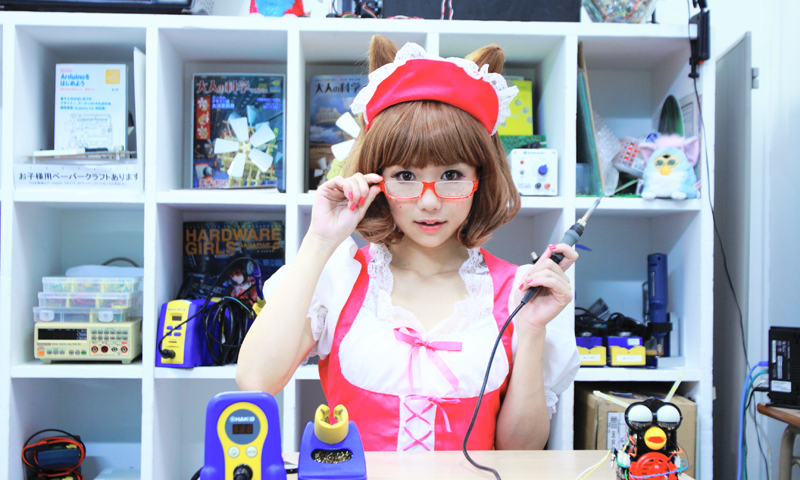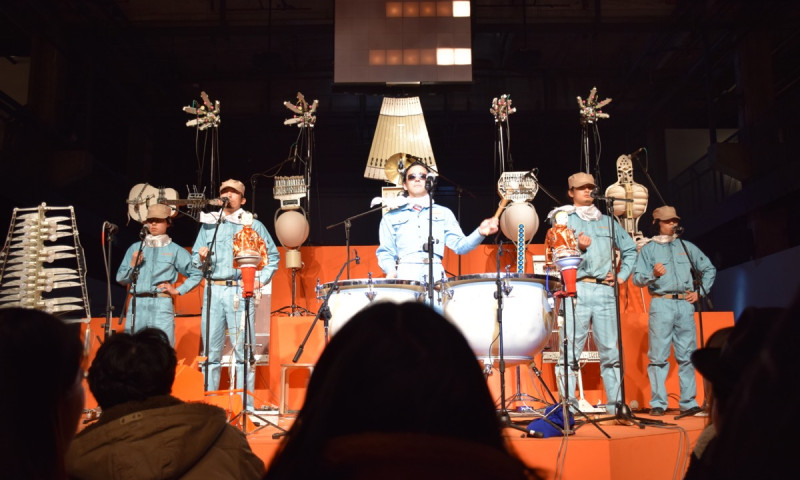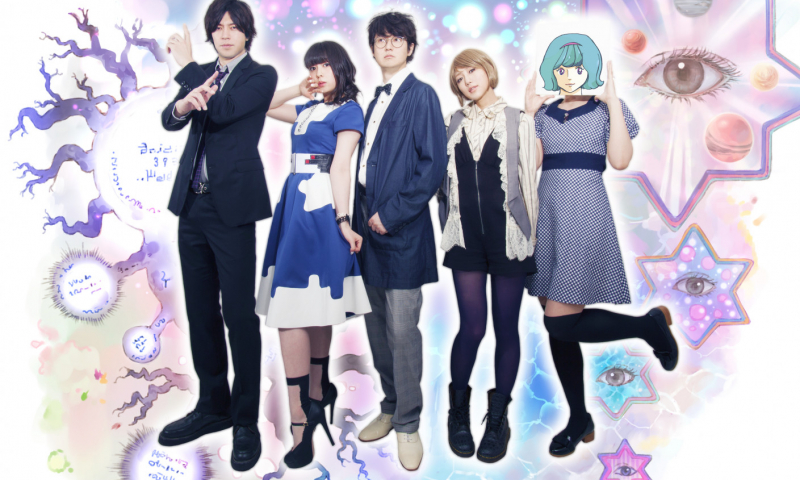
TOKYO CUTTING EDGE CREATORS by Julie Watai #11 featuring Frenesi: The Singer-Songwriting-Animator
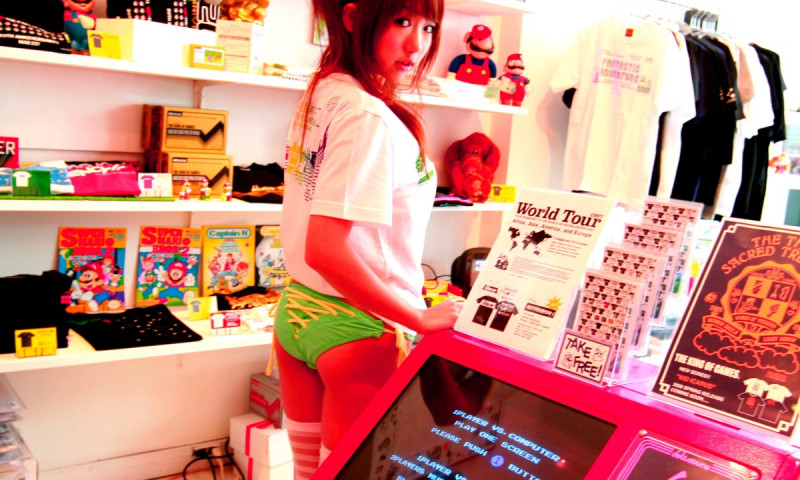
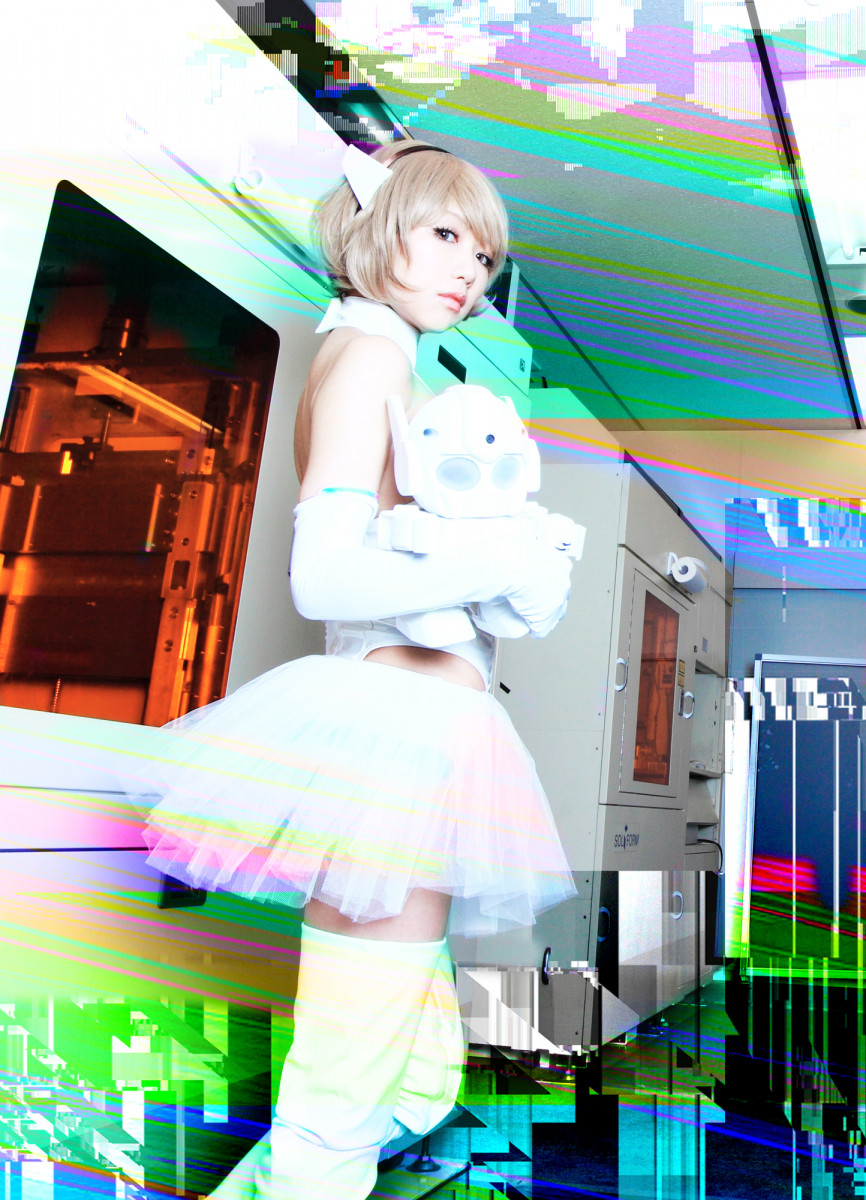
Sponsored Links
TOKYO CUTTING-EDGE CREATORS by Julie Watai is column series, which covers Tokyo’s latest cutting-edge culture! In this series she’ll be interviewing creators that have caught her interest, in order to discover the latest cutting-edge culture in Tokyo. We have interviewed Ai☆Madonna, Junya Suzuki from chloma, Etsuko Ichihara, TORIENA, and Tadashi Shimaya(the developer of female android ASUNA).
東京の最先端カルチャーを常に追いかけ続けているJulie Wataiさんの連載『TOKYO CUTTING-EDGE CREATORS by Julie Watai』。この連載では、Julie Wataiが注目するクリエイターとの対談を通じ、新たな東京の最先端カルチャーを発見していきます。初回では愛☆まどんなさん、第2回目ではchloma鈴木淳哉さん、第3回目では市原えつこさん、第4回ではTORIENAさん、第5回ではアンドロイドASUNAの開発者・島谷直志さんとインタビューを行ないました。
For the 6th installment, we welcomed Nukeme, who is especially known as a designer for “Nukeme Cap series”.
そして今回のゲストは、「ヌケメ帽」のデザイナーとして知られているヌケメさんです。
Julie: Hey, there- Good evening! I think it’s been about two months since we had our last chat. Thanks again for letting me borrow that costume during the shoot for your KADO: The Right Answer (Seikaisuru KADO) collaboration poster.
Julie : こんばんは。ヌケメさんにお会いするのは2か月ぶりですね。「正解するカド」コラボポスター撮影の際に、衣装をお貸し頂き、ありがとうございました。
What kind of title do you choose when it comes to getting credited for something? Like in my case, I just call myself an artist or photographer, but since you’re involved with so many different things, I’m kind of curious.
ヌケメさんの肩書きって、名乗るときはどうされているんですか?私なら平たくアーティストって言ってたりフォトグラファーだったりするんですが。色々な活動をされているので、ちょっと気になって。
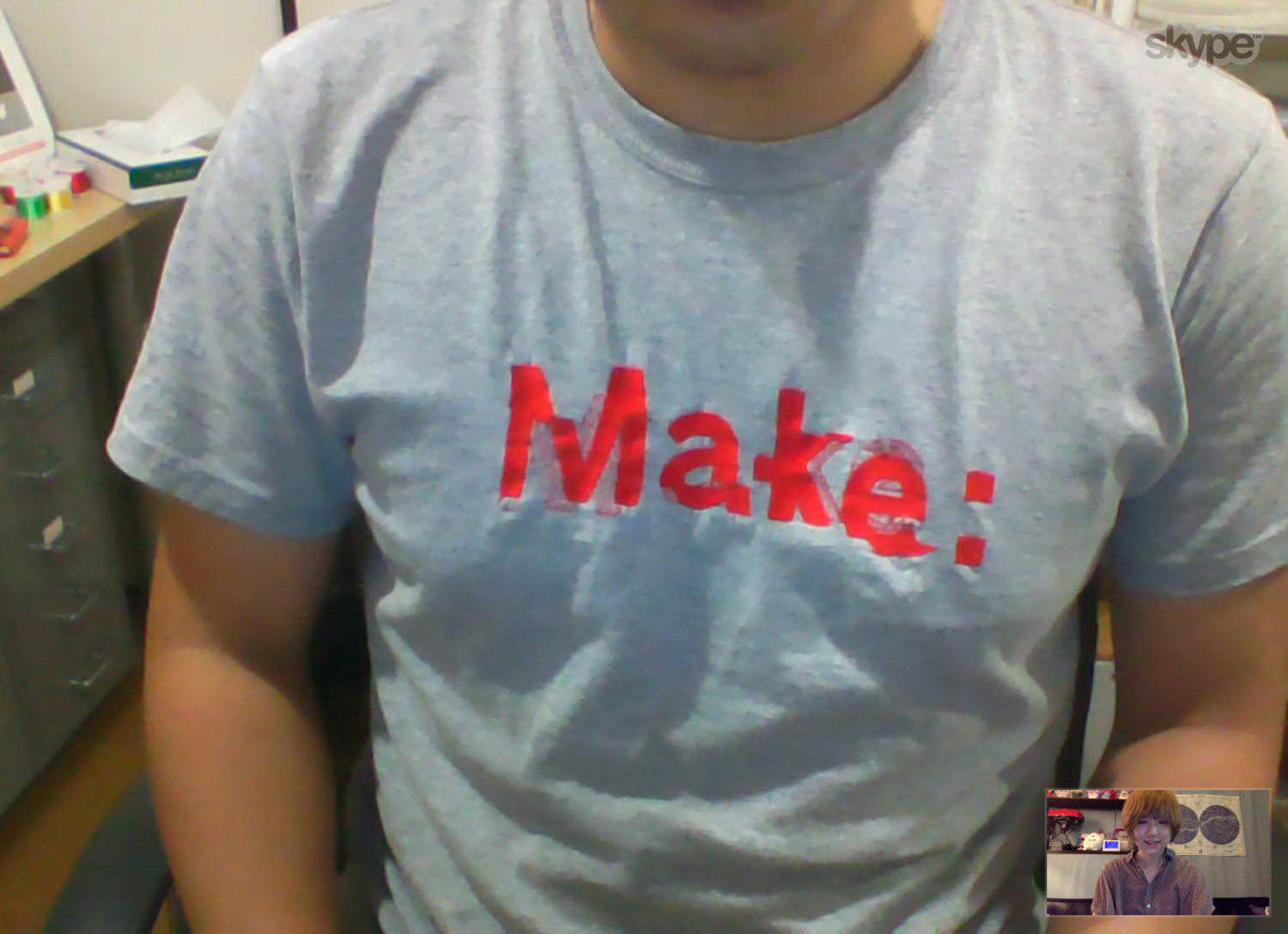
This interview was conducted on Skype. ヌケメさんとの対談はSkypeで行われました。
Nukeme: I often put fashion designer/artist in my profile, but recently I’ve also added “programming apprentice”.
ヌケメ: ファッションデザイナー/アーティスト、ってよくプロフとかには書いていて、最近は「プログラマ見習い」が追加されました。
Nukeme’s Profile
Born in 1986. Worked as design leader on the Nukeme Cap series, inspired by the poetry of Yoshinori Henguchi. From 2016 he became a programming apprentice at Semitransparent Design. This October he plans to launch his new brand OKAY.
ヌケメさんプロフィール
1986年生まれ。辺口芳典氏の詩を用いたシリーズ「ヌケメ帽」のデザイン担当。2016年よりSemitransparent Designでプログラマーの見習い中。同年10月に新ブランド「OKAY」を立ち上げる予定。
Julie: Oh? But why the apprentice part? (laugh)
Julie: えっ、なぜ「見習い」なんですか。気になる(笑)。
Nukeme: Well, I was hired on as a programmer at the company Semitransparent Design in February, despite having never programmed anything before, so I’m currently in the process of learning… I’ve never really heard people use the word “apprentice”, so I thought it would be an interesting choice.
ヌケメ: Semitransparent Design(1)っていう会社に今年の2月に入社したんですが、プログラム書いたことないのにプログラマとして入社して、会社で勉強中なので……。それに見習いってあんま聞いたことないしおもしろいかなと。
Julie: Oh, they’re a famous web design company! I see. But I think it’s impressive that you’re taking on work that you don’t have any background in like that! Is there something you want to do with programming that made you want to get into the industry?
Julie: あ、有名なWEBデザインの会社ですね。なるほど。でも未経験の仕事に就くのってすごいですね!プログラムでやってみたいことがあってその業種についたんですか?
Nukeme: No, nothing like that. (laugh) It was more like they just took in a stray dog like me. But I’ve always been into glitches, and thought programming would pair well with what I’ve been doing, so after they hired me and asked me what I wanted to do, I responded with, “Well, how about programming?” and things just kind of went from there.
ヌケメ: いえ、そういうわけではないんですがw野良犬の僕を拾ってもらったという感じです。でも元々グリッチ(2)とか好きですし活動との相性は良いと思うので、入社することが先に決まって、「なにしたい?」という話があって、「じゃあプログラマで」という流れです。
Julie: That’s a pretty amazing story. Programming has a creative feel to it, yeah? And didn’t your glitch artwork originally come from a sewing machine hack? The work I’ve seen of yours was full of concepts I’d never seen before, so I can’t help but imagine that trying out something completely new would influence that~
Julie: それもすごい流れだ。。クリエイティブ業種って感じですね。グリッチ作品はミシンをハックする(3)ところから来ていたんでしたっけ。ヌケメさんの作品はどれも見たことないようなコンセプトだったりするので、ご自身の中で全く新しい試みをやってそれが作品に反映されているのかな〜と妄想してしまいますね。
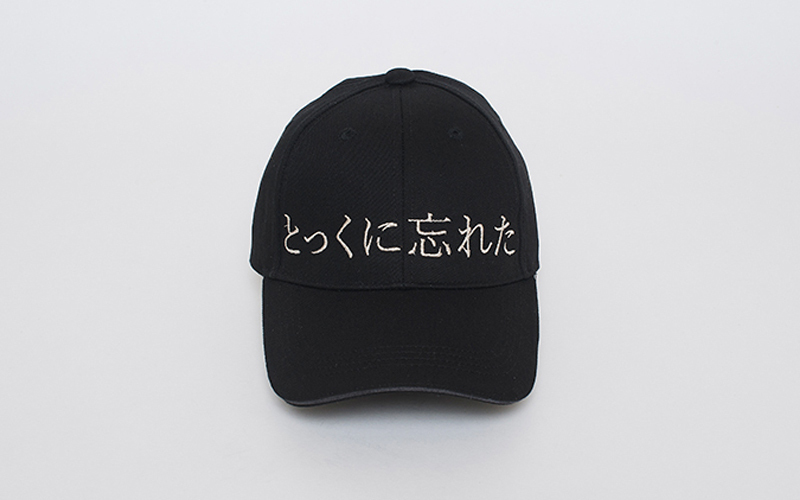
Word:Yoshinori HENGUCHI Design:Nukeme Photo:Hidemasa Miyake
Julie: Your Nukeme Caps definitely left an impression. The embroidered lettering on them attracted a ton of attention on the net when they were released, and so many artists and idols were wearing them. How did you come up with the idea?
Julie:ヌケメさんの作品というと「ヌケメ帽」(4)の印象があります。インパクトの有る言葉が刺繍されたキャップが発表と同時にネットでも話題になり、色々なアーティストやアイドルまでかぶっていてすごいなと思いました。この作品はどういった経緯で思いついたのでしょうか。
Nukeme: I started producing the Nukeme Caps in 2008, an acquaintance of mine, a poet named Yoshinori Henguchi, accepted a prose work offer while I was a fashion school student in Osaka. He’s recently got a website up, which looks like this: http://yoshinorihenguchi.com/
ヌケメ: ヌケメ帽は2008年から作っていて、大阪でファッションの専門学生やっていたんですが、その時に知り合った辺口芳典さんという詩人の方から、散文作品の提供を受けて作ってます。最近、辺口さんのサイトができたんですが、こんな感じです。 http://yoshinorihenguchi.com/
Julie: Wow, his site is really interesting! How fun is it that the text clickable as you scroll. It makes me really want to pay attention to every word. I know that the caps were embroidered with Henguchi’s prose, but did you choose which words to use? And why caps?
Julie: おおー、サイト面白いですね!スクロールして文字をクリックするのが楽しい作りですね。じっくり読みたくなってきます。キャップに刺繍されている辺口さんの散文ですけど、選んだのはヌケメさん?そしてなぜ帽子になったのでしょうか。
Nukeme: Thanks! Well, a lot went into it.
At first I just had an idea about making something with Henguchi, but seeing as there were already so many artist collaboration shirts out there, but not so many caps, and with it being so uncommon to use a Japanese language design, I thought it would be fun to do it that way. As for the lettering, in the beginning I just picked from the prose Henguchi sent me, but recently I’ve been tossing out theme ideas to him, and then he’ll reply back to me with prose that fits that theme.
ヌケメ: あざます!いろいろありましてですね。最初に「辺口さんと一緒に何かつくりたい」というアイデアがまずあって、アーティストコラボのプリントTとかはよくあるけど、キャップはあんまりないし、日本語のデザインというのも珍しいので、作ってみるのは面白いんじゃないかと。で、言葉に関しては、最初は辺口さんから送られてくる言葉の中から、僕が選んでたんですけど、最近は僕からなにかテーマを投げて、それに対して辺口さんが言葉で返してくる、というやり方をとってます。
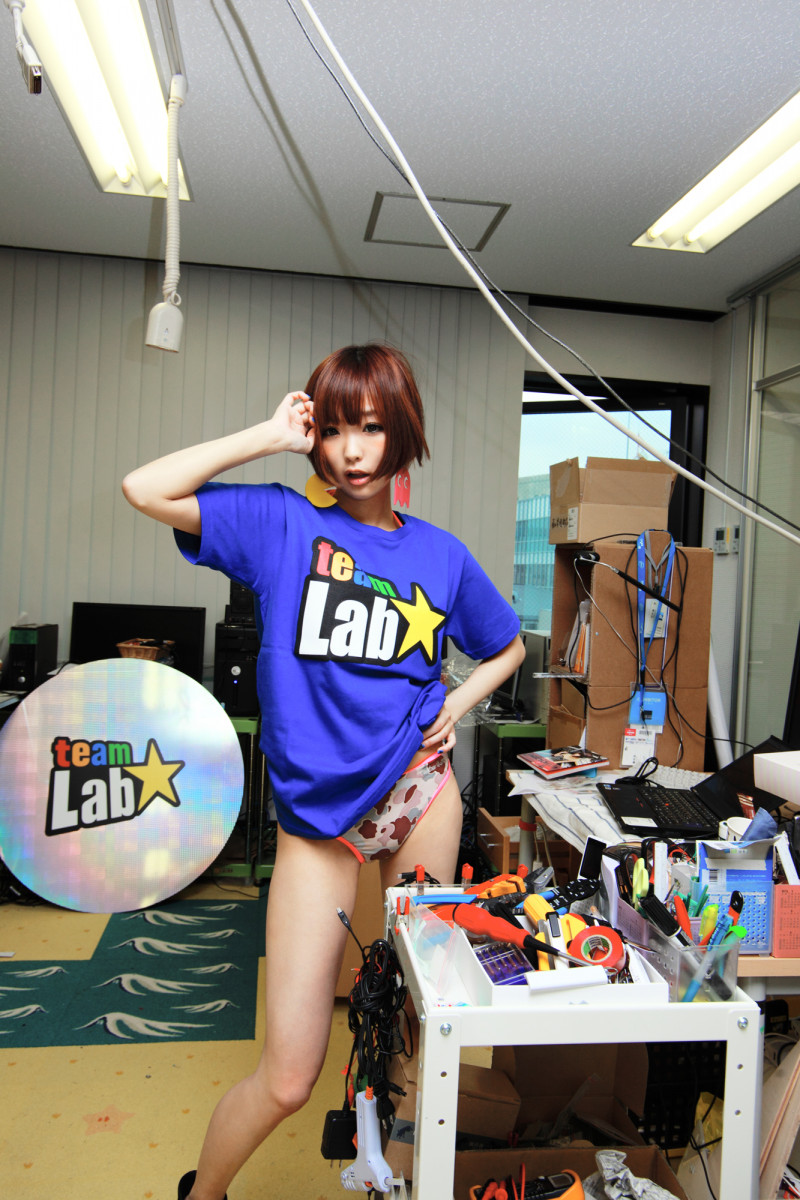
Photo : JulieWatai Model : Yun*chi Room : team Lab
Julie: You’re right, there’s not a lot of caps out there. What kind of themes do you give to Henguchi?
Julie: 確かにキャップはなかなか無いでしょうね。辺口さんに投げるテーマ、例えばどういったテーマがあったのでしょうか?
Nukume: Like when I gave him the theme “Suiyoubi no Campanella” (electronic music unit), he came back with “Yie Ar Sosuu Pythagoras Chuu”.
ヌケメ: 「水曜日のカンパネラ」というテーマを投げたら、「イーアル素数ピタゴラス中」という言葉が返ってきたり。
http://nukeme.thebase.in/items/1522566
Julie: Even though they’re just words, I’m completely taken aback!
Julie: なんか言葉だけなのに、いきなり度肝を抜かれてしまいましたけれども!
Nukeme: Then, for the theme “brand-new white sneakers”, he came back with, “genjitsu no mae no hi” (“yesterday’s reality”)
ヌケメ: 「新品の白いスニーカー」というテーマを投げたら、「現実の前の日」という言葉が返ってきたり。
http://nukeme.thebase.in/items/3463137
Nukeme: Right? (laugh) Basically since they’re inspired writings, it’s fun to see all the things he comes up with.
ヌケメ: はい、そうですよねw 一応、インスピレーションについては書いてあるので色々想像しながら見てもらえると楽しいかなと。
Julie: Just those words (brand-new white sneakers) feel like they’re somehow connected to me. (laugh) It’s cool how each product page on the site includes a backstory~
Julie: なんかこの言葉(新品の白いスニーカー)だけは自分的に繋がった気がします(笑)サイトの商品ページではそういった経緯も説明されていて面白いですね~。
Nukume: Coming up with the themes is the really fun part.
ヌケメ: テーマを考えるのは結構楽しいです。
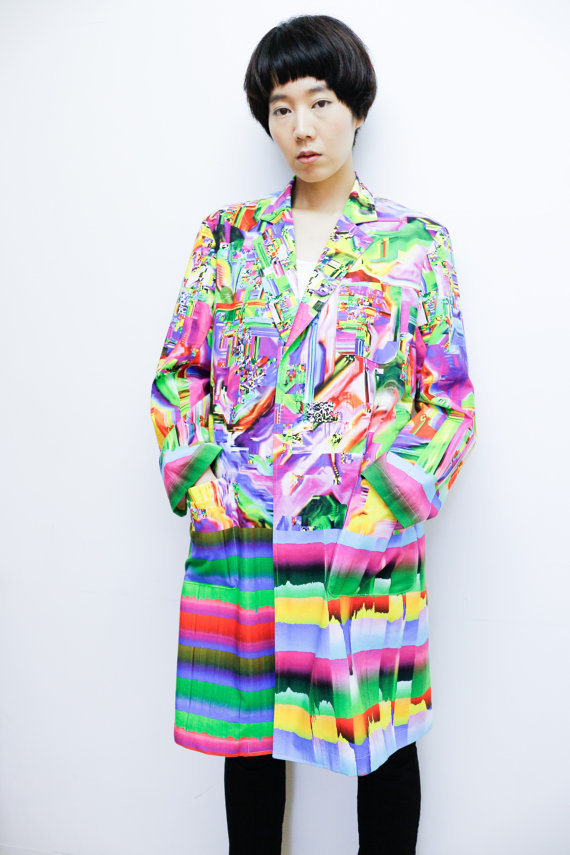
Coat by Nukeme and Ucnv Photo:Takawo Model:Asami SHIBUYA
Julie: The glitch coat from your collaboration with ucnv also got a lot of retweets on Twitter. I’ve even borrowed it for a costume. It has such an impact when worn, that I’ve gotten compliments wearing it out. The way it falls when worn is cool, too. It’s like there’s a person emerging from color space of the broken up RGB (digital color gamut depicted on an LCD monitor).
Julie: ucnv(5)とのコラボのグリッチコートもsnsでめっちゃRTされてましたよね。私も衣装としてお借りしたことがあります。着るとインパクトがすごくて現場で褒められました。着た時の形もかっこいいです。印刷がパキッとしていてRGB(液晶モニターで表現されるデジタル色域)の色空間の人が現実に出てきた!って感じでした。
Nukume: Thanks! It is pretty vivid and bright.
ヌケメ: 派手さがすごいですよね。ありがとうございます!
Julie: How were you involved in this particular collaboration?
Julie: このコラボではヌケメさんはどういった関わり方をされていたんでしょうか。
Nukume: I was responsible for stitching the clothing on the mannequin. The print was a capture we used of ucnv’s work titled Turpentine. So it was the same kind of deal as with Henguchi. I asked them to work on something with me, and then I was responsible for turning it into clothing, kind of like that.
ヌケメ: 僕は洋服のフォルムと縫製担当です。プリントしているのはucnvさんのTurpentineという作品のキャプチャ画像を使っています。(http://ucnv.org/turpentine/) そういう意味では辺口さんとの関わり方と似てますね。作品を提供してもらって、僕は洋服として生産する部門の担当、という感じです。
Julie: Your output really expresses itself in clothing. When it comes to glitch artists, ucnv is the real deal. His stuff is pure glitch. It’s amazing.
Julie: ヌケメさんの表現のアウトプットが洋服になるんですね。ucnvさんはガチのグリッチアーティストですね。ピュアグリッチですよね。すごい。
Nukume: Oh yeah! I agree he’s the real deal, but because saying “pure glitch” carries as sense of “unintentional glitches”, it’s a controversial trend, but for ucnv, although his intention is to make artwork with glitches, he approaches it with the attitude of actually using breaks in data. So he’s not just making glitch-style graphics, but actually corrupting the data, which is what I believe makes it actual glitch.
ヌケメ: あー! ガチのグリッチアーティストだと僕も思いますけど、「ピュアグリッチ」っていうと「意図せず現れたグリッチ」っていうニュアンスが含まれるので、論争になる気配がucnvさんは、グリッチを作品にする、という意味での意図はしてるけど、データは本当に壊してる、という態度かと。「グリッチ風グラフィック」では無くて、ほんとにデータを壊してる、という意味ではガチグリッチだと思います。
Julie: Oh, there are a lot of different ideas about it, then. About the fundamentalism of it. Let’s just leave things there. (laugh)
Julie: あ、そこは色々な思想がありますからね。原理主義が。ここいらでやめておきます(笑)。

Photo/Model : Julie Watai Robot : Rapiro
Nukume: Are you an acquaintance of ucnv?
ヌケメ: Julieさんはucnvさんと面識はありますか?
Julie: Not at all. I just know of him.
Julie: いえ、全くなんです。一方的に知ってます。
Nukume: Oh, but your Skype icon is from the Shibukaru festival. And I think ucnv went to see your photography art on exhibit there.
ヌケメ: おー。今JulieさんのSkypeのアイコンになってる、シブカル祭。で展示されてた写真作品はたぶん見に行ってますよ、ucnvさん(6)。
Julie: Ahhh! Admittedly I’m a little embarrassed! I can only apologize at how trying to do something and call it glitch art makes it shallow as a cultural layer!
Julie: きゃー。なんかもう恥ずかしい。これはグリッチアートとしてみると文化レイヤーが浅めの表現なので申し訳なさでいっぱいです!
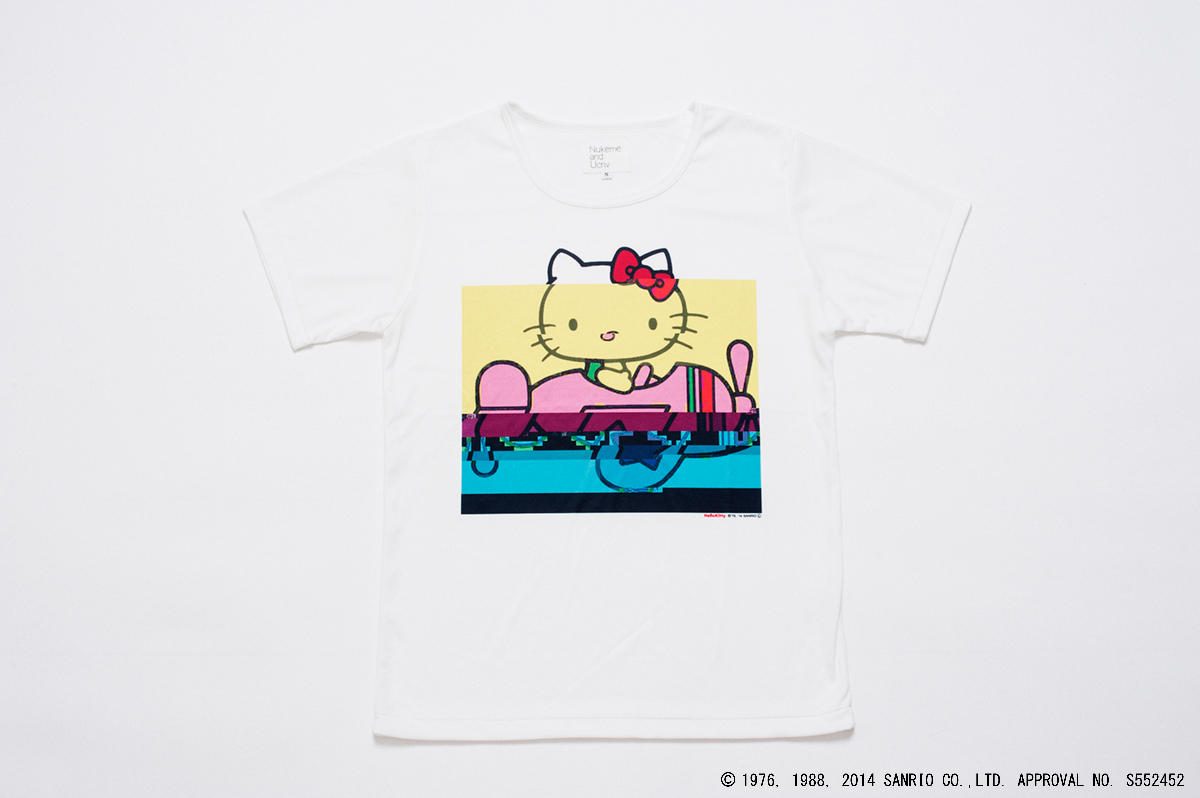
Sanrio x Glitch by Nukeme and Ucnv
Julie: Then after that, you and ucnv did a Hello Kitty collaboration with Sanrio and released glitch designs of popular characters. How did people react?
Julie: その後、ucnvさんとはサンリオとのコラボでキティちゃんなど人気キャラクターのグリッチデザインのものが発売されましたね。周りの反応はいかがでしたか?
Nukume: That was also all ucnv~. He designed the printed t-shirts and I did the glitch embroidery. It’s all a little fuzzy, but for the most part the two of us went and had a meeting at Isetan where we came up with things as we were discussing it. Of course, as an individual doing an official collaboration with Sanrio, the response was huge.
ヌケメ: あれもucnvさんとの仕事でしたね~。プリントTシャツはucnvさんの作品で、グリッチ刺繍が僕の仕事なんです。よくごっちゃにされてしまうのですが。企画の全体像は僕ら2人と伊勢丹さんで打ち合わせしながら考えました。やっぱり、個人でサンリオと公式コラボする、ということの反応は大きかったと思います。
Recently the collaboration I did with Urusei Yatsura was released (http://store.natalie.mu/html/page116.html) , and I think it was all thanks to the work I did with Sanrio.
最近、「うる星やつら」コラボ作品をリリースしたんですが(http://store.natalie.mu/html/page116.html)これもサンリオとの仕事があったからこその案件だったな、と思います。
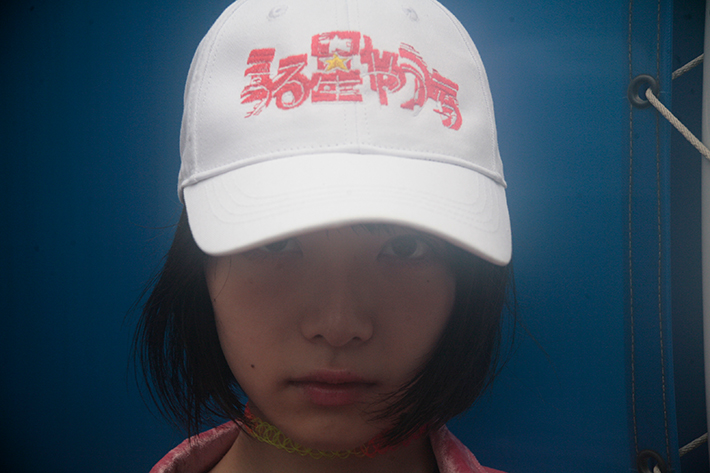
うる星やつら by グリッチ刺繍
©高橋留美子/小学館
Styling:Koji OYAMADA Photo:Nozomu ISHIMURA Model: ririka
Julie: That makes sense. When the collaboration came out, I was surprised that regular Sanrio fans who weren’t familiar with glitch, were totally buying it. I don’t know anything about sewing, but was embroidering the glitches a difficult process?
Julie: そうなんですね。私はサンリオコラボで出た時も驚きましたがグリッチとか知らない普通のサンリオファンの方も購入しているんでしょうね。私はお裁縫は全くなんですが、そもそもグリッチを刺繍にするのって大変な工程じゃないですか?
Nukume: For Sanrio, things really got intense after Karin Miyamoto from Juice=Juice wrote about it on her blog.
Well, embroidering itself is really tough. The physical part of it takes a lot of time. When it comes to putting glitches into the data, not so much.
ヌケメ: サンリオの時は、Juice=Juiceの宮本佳林ちゃんさんがブログで書いてくれていたのが激アガりでした。(http://ameblo.jp/juicejuice-official/entry-11891550119.html) うーん、刺繍するの自体はすごい大変です。物理的な刺繍の時間がめちゃくちゃかかるので。でも、刺繍データをグリッチさせること自体は、そんなに大変ではないです。
Julie: In order to glitch the embroidery data, did you hack the sewing machine’s computer parts?
Julie: 刺繍データをグリッチさせるって、それはミシン側のコンピューターの部分をハックするってことですか?
Nukume: No, it was done on my PC. From the process of turning image data (.jpg, .png, .bmp, etc.) into embroidery data (.pes), and then doing the embroidery, I fiddled with the .pes data. .pes is a special embroidery data format from Brother for their embroidery machines.
ヌケメ: いえ、PC側のデータのほうです。画像データ(.jpg,.png,.bmp…etc)→画像データから作成した刺繍データ(.pes)→実際に刺繍する、という工程で、僕がいじってるのは.pesのデータの部分です。pesというのはbrotherが開発した、brother刺繍機用の独自の刺繍データフォーマットです。
Julie: So you glitched the original image file on your PC, which modified the output on the machine. I’d never heard about .pes before.
Julie: 元となる画像ファイルをPCでグリッチさせて、さらにミシン用に出力したデータも改変するんですね。pesって初めて聞いた。
Nukume: Well it’s not really putting glitches into the original file.
ヌケメ: あ、画像ファイルをグリッチさせてるわけではないんです。
Julie: Oh?
Julie: あ、そうなんですか。
Nukume: This might be kind of confusing, but .pes is an xy-axis data format for embroidery machines.
ヌケメ: そこややこしいとこなんですが……pesっていうのは、刺繍ミシン用の、xy軸データなんです。
Julie: So vertical and horizontal axis data, right?
Julie: 縦横の軸のデータなんですね。
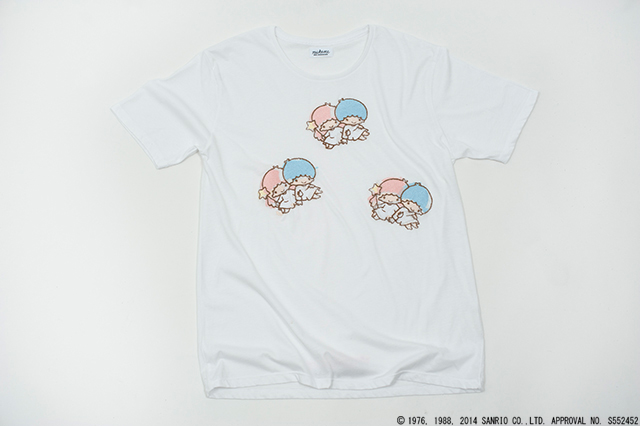
Sanrio x Glitch by Nukeme and Ucnv
Nukume: That’s right. It would probably be easier to explain by showing you in person. I think you, especially, would quickly understand it.
ヌケメ: ですです。むしろ目の前で作業をお見せしたいくらいなのですが。Julieさんならたぶんそのほうが理解が早そう。
Julie: It’s probably difficult for you to explain in words. Sorry to get so caught up in the details. Are you by chance the only person in the world attempting something like this?
Julie: 言葉で説明するのって大変ですよね、掘り下げてしまってごめんなさい。でもこういった試みってやっている人ってひょっとして世界中でヌケメさんくらいなのでは?
Nukume: If you mean glitch embroidery, then Melissa Berron was doing it before me by directly putting glitches into the embroidery data, but currently I think I might be the only one. (http://melissabarron.net/)
ヌケメ: グリッチ画像を刺繍化する、という意味ではMelissa Berronという人が先にいるのですが、刺繍データを直接グリッチさせる、というのは、今のところ僕だけだと思います(http://melissabarron.net/)。
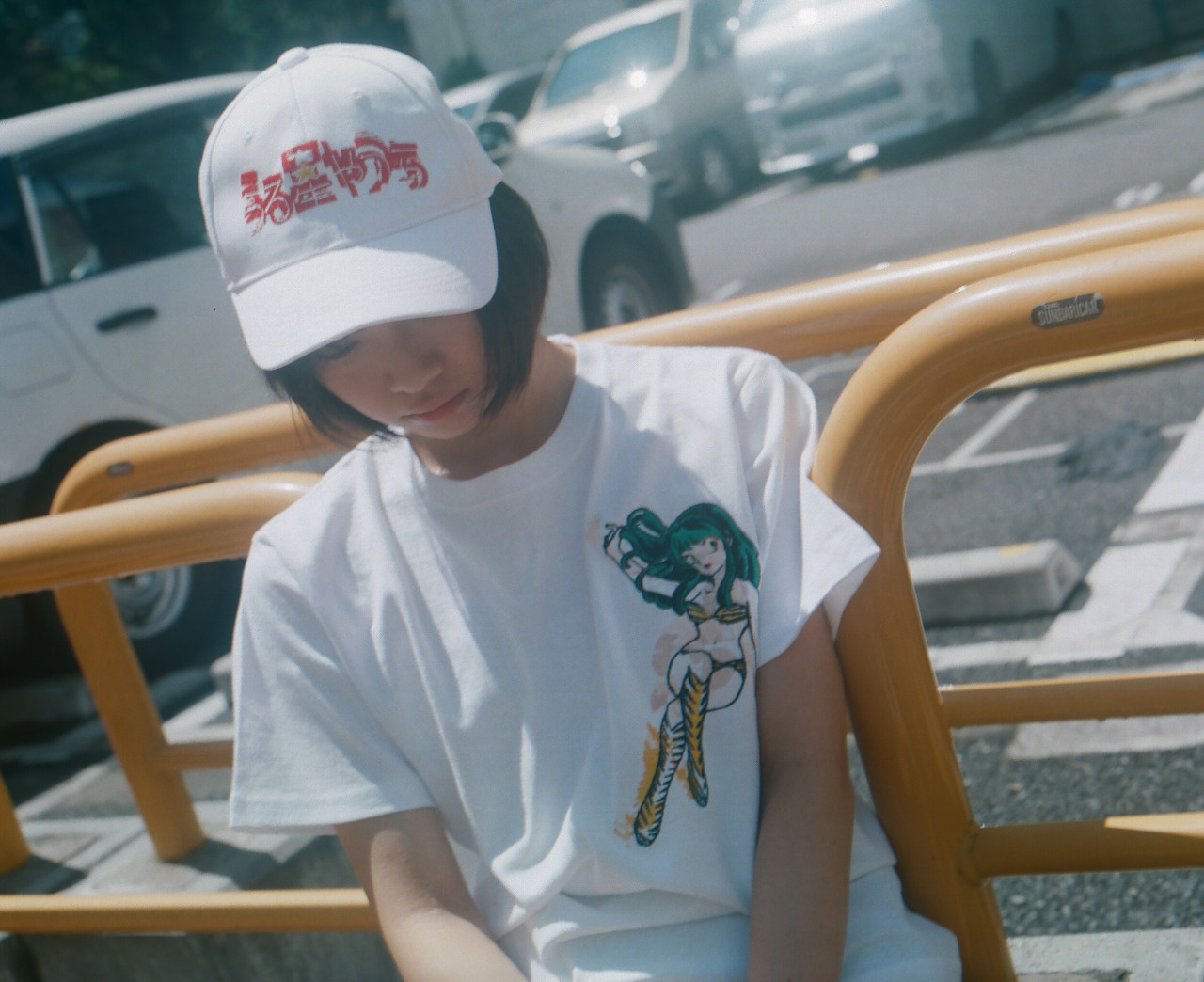
うる星やつら by グリッチ刺繍
©高橋留美子/小学館
Styling:Koji OYAMADA Photo:Nozomu ISHIMURA Model: ririka
Julie: Going back to our previous topic, your Urusei Yatsura collaboration was picked up by the media, right? Working on a collaboration with a famous animation, was there anything you particularly took into consideration?
Julie: 先ほどもお話いただいた、うる星やつらとのコラボレーションが今メディアにも取り上げられてますね。今回のコラボは名作アニメーションということで特に意識した部分はありました?
Nukume: Not anything just because it’s a famous work, but because it’s personally a favorite work of mine, I set the bar high. If we’re talking manga, it’s my favorite series. Like, of all time.
ヌケメ: 名作だから、という意識は特にないですが、個人的に好きな作品なので、そういう意味でのハードルは高かったです。漫画なら、うる星やつらが一番好きな作品なので。あらゆる作品の中で。
Julie; So for you, it kind of has a god-like status! You must have really felt the pressure, then. The glitch work is really stylish, and it really came out great as a wearable design.
Julie: それって相当自分の中での神作品ってことですよね! それはプレッシャーも凄そう。グリッチもおしゃれで、「洋服」のデザインとして着た時にもしっくりとくる表現をされているところはさすがだなと思いました。
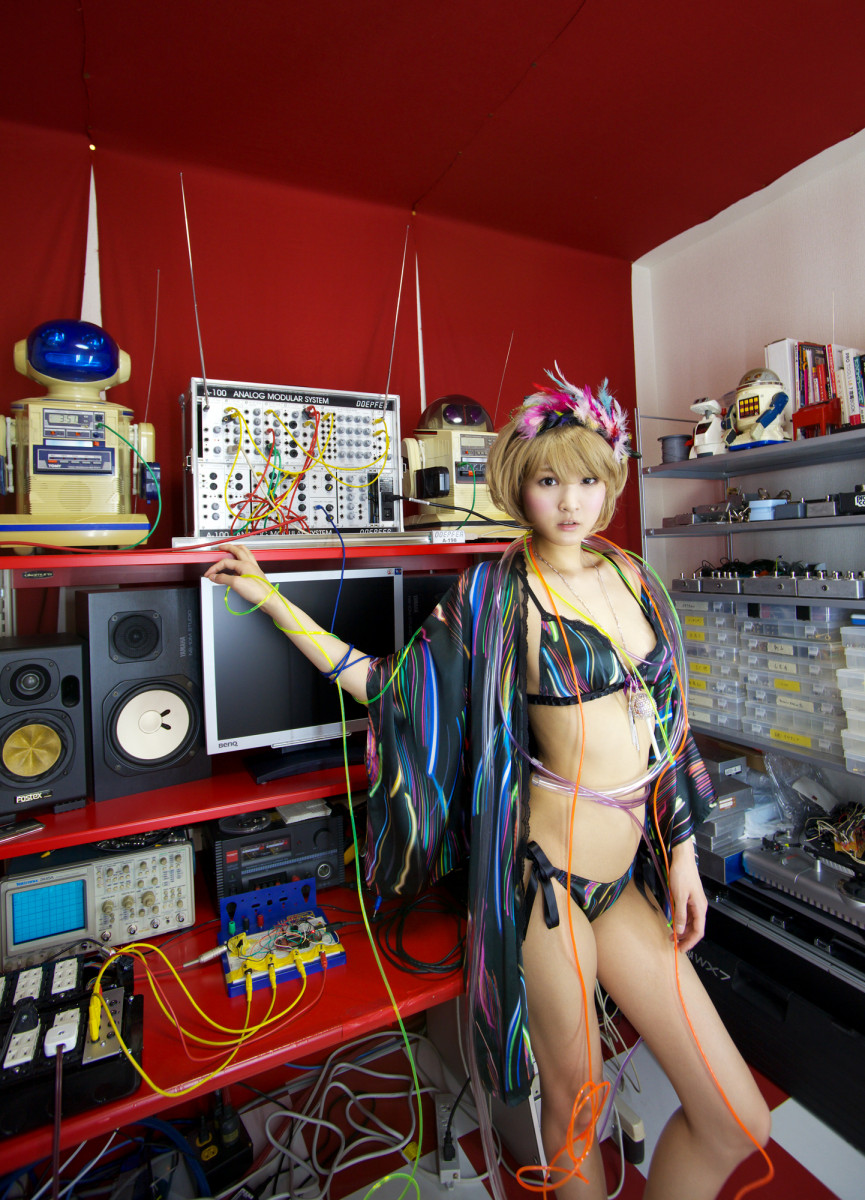
Photo : Julie Watai Model : Yurika Kubo
Julie: I’d like to take a moment to talk about your work titled Old School, that you came out with in 2015. But it’s not a wearable apparel design, right? You took the WINDOWS logo and did a UV print of it on a block of wood, but I wasn’t able to see the real thing. Could you tell me more about it?
Julie: 2015年に発表されたオールドスクールというタイトルの作品なんですが。こちらはアパレルではないですね。WINDOWSのマークが立方体の木にUVプリントされていますが、私は生で拝見したことがなくて。どういった作品なのでしょうか。
Nukume: It’s hard for me to explain what Old School is… I was going off a personal theme of wanting to carve an image.
ヌケメ: Old Schoolの説明は、難しいです……「画像を彫る」というのが、自分の中でのテーマではありました。
Julie: Oh, you had mentioned making sculptures last time. So this piece’s unevenness is from hand-carving it?
Julie: あ、以前に彫刻をしているって言ってましたよねこちらの作品の凹凸も手彫りで?
Nukume: Oh, you mean the Buddha statue! I think that was around the time I was making these Old School practice pieces. They’re all hand-carved.
ヌケメ: あ、仏像ですよね! それはOld Schoolの習作を作っているタイミングだったと思います。全部手彫りです。
Julie: Wow, so these creations were the basis for your most recognized work.
Julie: すごい、あらゆる創作がヌケメさん名義の作品の元になっているんですね。
Julie: You’ve come out with a lot of pieces, but I feel like this one concept is the “nucleus” that all of the others share. So what exactly is it? Sorry for the strange question. But I feel like this one has some kind of core to it…
Julie:色々な形で作品を発表されていますが、共通してヌケメさんの「核」となっているコンセプトは存在するように見えます。それはなんですか? 聞き方が変ですね、すみません。たぶんコアになる部分があるんじゃないかなと思っているのですが……。
Nukume: It’s a little difficult to say, but I guess it would be “discomfort”.
ヌケメ: 難しいですが、「違和感」ですかね。
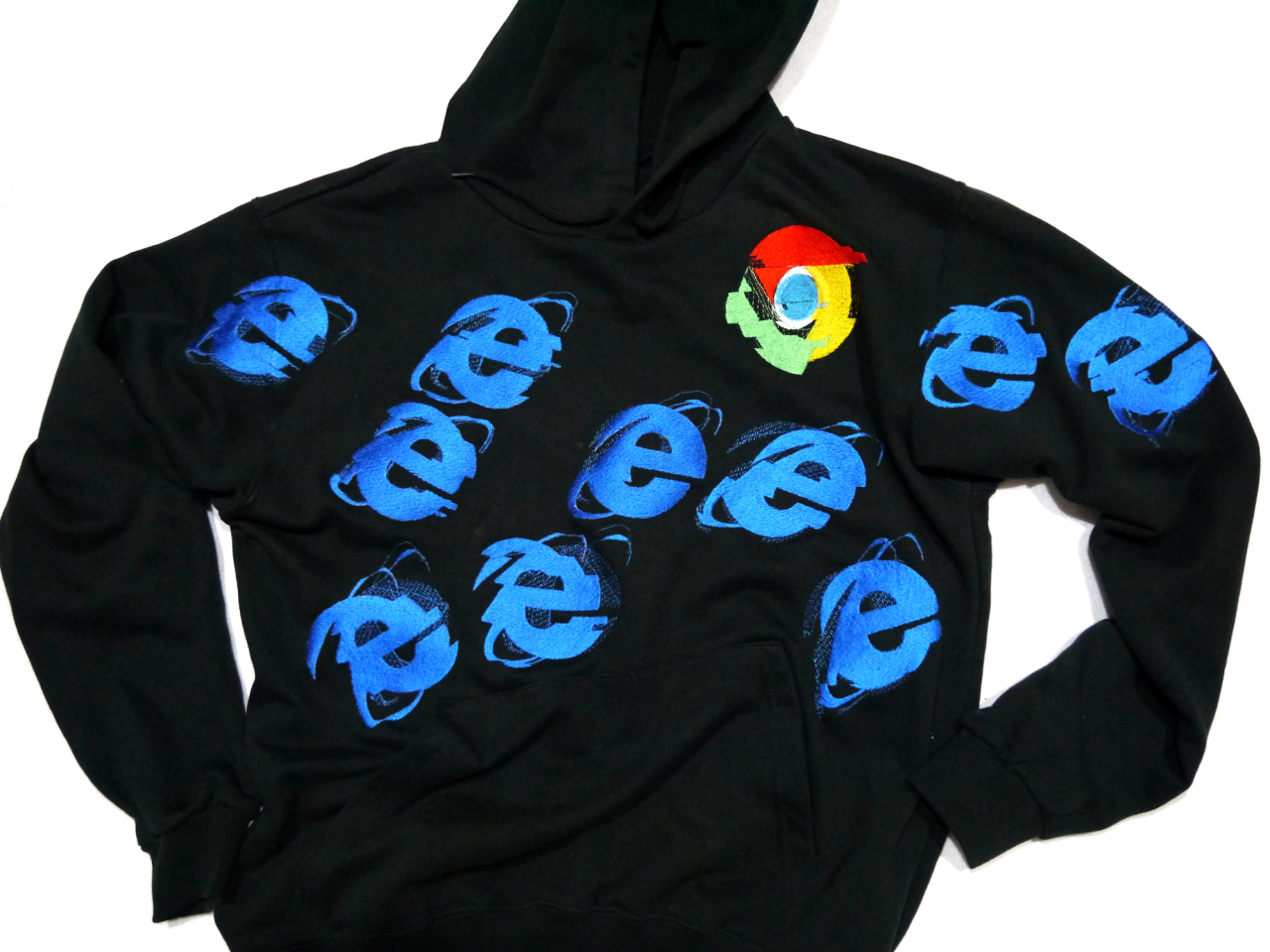
Julie: I see! That really fits! There is a slight feeling of discomfort when looking at this piece, which come to think of it, is really representative of your work in general. Well, to wrap things up, is there any genre you’d like to try your hand at or something you’d like to try to express in the future?
Julie: ああ、違和感。しっくりきました! 作品を一見した時に生じる絶妙な違和感が、ヌケメさんの作品性なんだなって今理解できたような気がします。では最後に、今後挑戦してみたいジャンルや表現はありますか?
Nukume: Writing a novel.
ヌケメ: 小説です。
Julie: !! There’s that sense of discomfort again!!! I don’t think this could be connected in anyway with what you’ve been doing!!
Julie: !! またもや突然の違和感が!!!全然ヌケメさんのこれまでの活動と繋がらない!!
Nukume: (laugh) In the end, I think that it would be fulfilling enough to express what I want to using only words, and for that a novel would be the format.
ヌケメ: (笑)。最終的には、自分の表現したいものが、言葉だけで表現できたらそれで充分だな、と思っていて、フォーマットとしては、小説になるのかな、と思っています。
Julie: So you’re moving towards more minimal representations.
Julie: 表現がどんどんミニマルに向かっているんですね。
Nukume: I like abstract better. I think words are the ultimate abstract form.
ヌケメ: 抽象的なほうが好きですね。言葉は抽象の究極だと思うので。
Julie: I’d be really interested to read a novel from you. You’re right, depending on how they resonate with each reader, the image of the words changes.
Julie: ヌケメさんの書く小説、すごく興味ありますね。そうですね、言葉は読んだ人ごとに具現化されるイメージが変わりますしね。
Nukume: Yes, they’re played out directly in that person’s mind.
ヌケメ: そうですね、その人の脳で直接再生される表現と思います。
Julie: I’m looking forward to seeing what you work on in the future.
Julie: 今後もご活動、楽しみにしています。
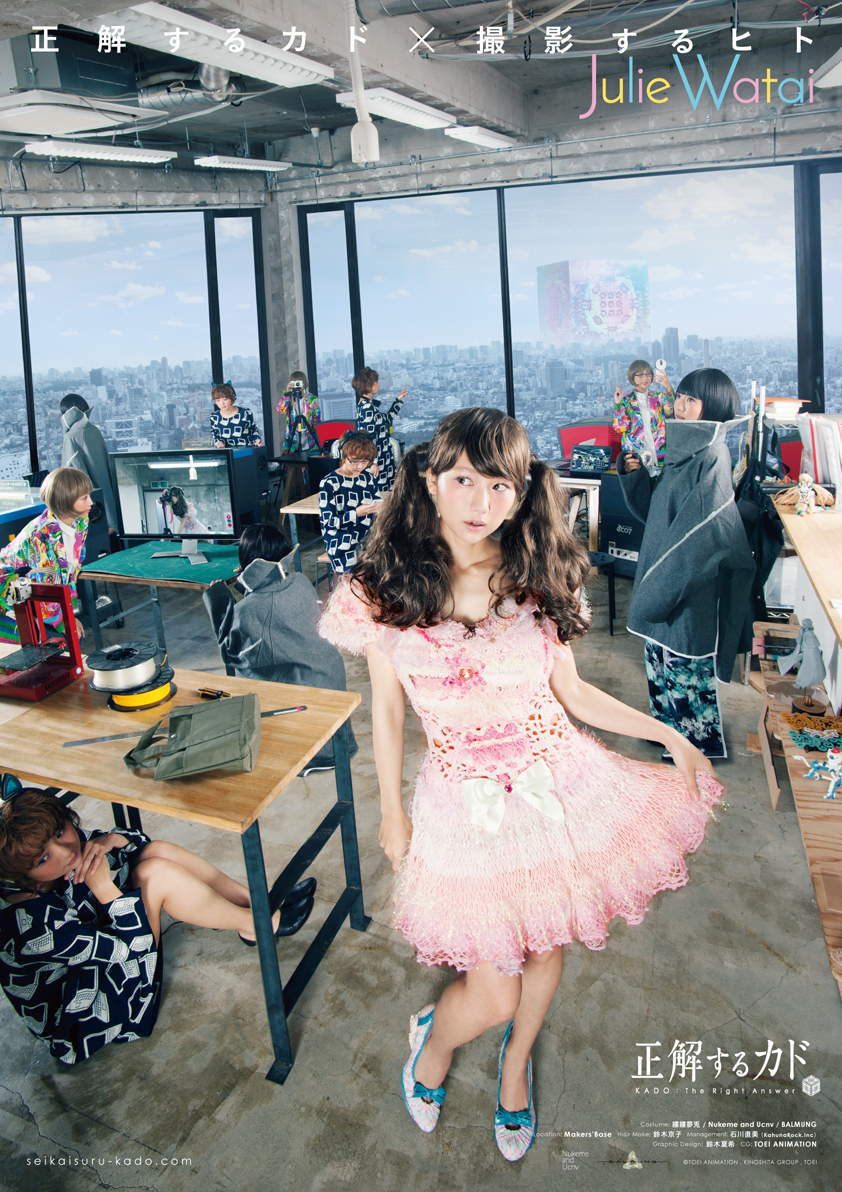
“Seikai suru Kado” Toei Animation collaboration poster 「正解するカド」東映アニメーション コレボレーションポスター Photo/Model : Julie Watai Coat by Nukeme and Ucnv Nukeme lent me a glitch coat as costume for this poster. グリッチコートを衣装としてヌケメさんからお借りしました。
After the Interview/対談を終えて
There’s something that came to my mind as I listened to Nukume and viewed his works. While I think there’s genres that incorporate the essence of street culture into the field of fashion, in Nukume’s case, I think it’s the internet instead. Before, young people would take to the streets with different kinds of culture, but now that’s transitioning to the internet, where according to culture critics, the internet began to spread to households from around the year 2000. The last diffusion of culture is one that was achieved completely through the internet. Nukume has extracted the deepest part, or the core of it, and used the mass approach of fashion as a means of output. That Nukume has taken his so-called sense of “discomfort” and turned the reality of the floating web, where giving shape to groups of information is difficult, and given it a form through clothing, and in that way, eroded that which seems natural from day to day, is something major, I believe.
ヌケメさんのお話や作品を見ていて個人的に思っていた事があるんです。ファッションの分野にはストリート文化のエッセンスを取り入れたジャンルがあると思いますが、ヌケメさんの場合はそれがインターネットなんじゃないかと考えています。一昔前に若者たちから様々な文化が発信されてきたストリートという場が、いまやインターネットに移行したということが、一般家庭にネットが広く普及しだした2000年ごろから文化評論家たちが話してきました。あくまでも文化的な広がりはインターネットの中だけで完結しています。ヌケメさんは最深部ともいえるコアな部分を抽出してファッションというマスな手法でアウトプットしていますよね。ヌケメさんの言う「違和感」の正体はネットに漂う現実では形容しがたい情報群が洋服という形で、さも当たり前に日常に侵食しているというところが大きいのかもしれない、と思います。
References
(1) Semitransparent Design http://www.semitransparentdesign.com/
(2) gli.tc/h is just one example: 例えば代表的なところだとgli.tc/hなど http://gli.tc/h/
(3) Glitch embroidery: グリッチ刺繍 https://vimeo.com/60466854
(4) Nukume Cap catalogue: ヌケメ帽一覧 http://nukeme.thebase.in/
(5) ucnv’s website: ucnvさんのサイト http://ucnv.org/
(6) ucnv’s Twitter: ucnvさんのTwitter https://twitter.com/ucnv/status/391232148847333376
Translated by Jamie Koide
Sponsored Links
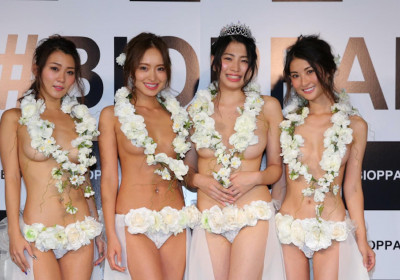
The Most Beautiful Breasts in Japan as Determined by Women: BIOPPAI Contest 2016

Risa Satosaki Reveals Everything in the MV for “S!NG”!


